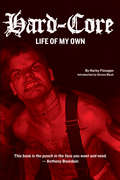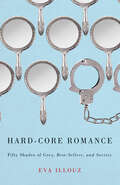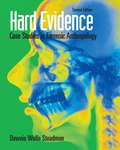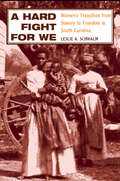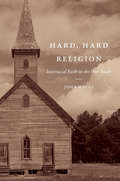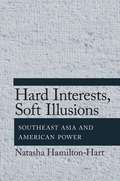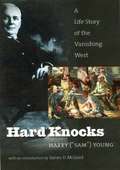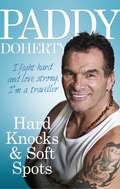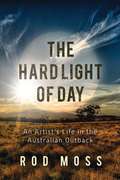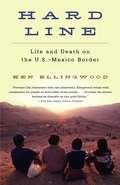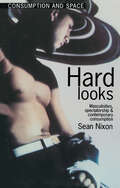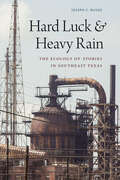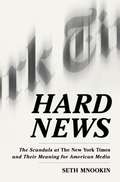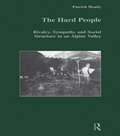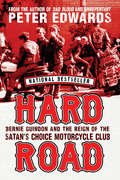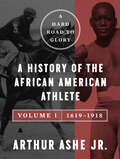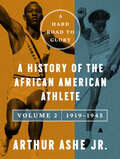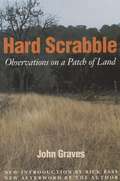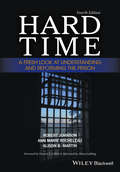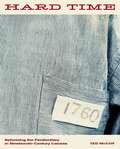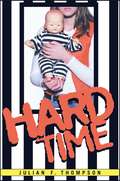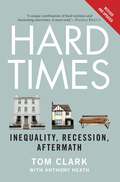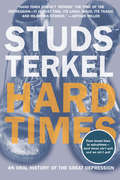- Table View
- List View
Hard-Core: Life of My Own
by Harley Flanagan Steven BlushAs a homeless child prodigy, Harley Flanagan played drums for bands at Max's Kansas City and CBGBs, and was taught to play bass by the famed black band Bad Brains, and drank with the notorious Lemmy of Motörhead. Most famously, Harley became a member of the famous hardcore band The Cro-Mags, and disputes accusations of stabbing two band members.
Hard-Core Romance: Fifty Shades of Grey, Best-Sellers, and Society
by Eva IllouzFrom its beginnings in Twilight fan-fiction to its record-breaking sales as an e-book and paperback, the story of the erotic romance novel Fifty Shades of Grey and its two sequels is both unusual and fascinating. Having sold over seventy million copies worldwide since 2011, E. L. James’s lurid series about a sexual ingénue and the powerful young entrepreneur who introduces her to BDSM sex has ingrained itself in our collective consciousness. But why have these particular novels—poorly written and formulaic as they are—become so popular, especially among women over thirty? In this concise, engaging book, Eva Illouz subjects the Fifty Shades cultural phenomenon to the serious scrutiny it has been begging for. After placing the trilogy in the context of best-seller publishing, she delves into its remarkable appeal, seeking to understand the intense reading pleasure it provides and how that resonates with the structure of relationships between men and women today. Fifty Shades, Illouz argues, is a gothic romance adapted to modern times in which sexuality is both a source of division between men and women and a site to orchestrate their reconciliation. As for the novels’ notorious depictions of bondage, discipline, and sadomasochism, Illouz shows that these are as much a cultural fantasy as a sexual one, serving as a guide to a happier romantic life. The Fifty Shades trilogy merges romantic fantasy with self-help guide—two of the most popular genres for female readers. Offering a provocative explanation for the success and popularity of the Fifty Shades of Grey novels, Hard-Core Romance is an insightful look at modern relationships and contemporary women’s literature.
Hard Evidence: Case Studies in Forensic Anthropology
by Dawnie Wolfe SteadmanAn essential supplement to a forensic anthropology text, this reader provides case studies that demonstrate innovative approaches and practical experiences in the field. The book provides both introductory and advanced students with a strong sense of the?cases?that forensic anthropologists become involved, along with?their professional and ethical responsibilities, the scientific rigor required, and the multidisciplinary nature of the science. For courses in Forensic Anthropology and Forensic Science.
A Hard Fight for We: Women's Transition from Slavery to Freedom in South Carolina (Women, Gender, and Sexuality in American History)
by Leslie A. SchwalmAfrican-American women fought for their freedom with courage and vigor during and after the Civil War. Leslie Schwalm explores the vital roles of enslaved and formerly enslaved women on the rice plantations of lowcountry South Carolina, both in antebellum plantation life and in the wartime collapse of slavery. From there, she chronicles their efforts as freedwomen to recover from the impact of the war while redefining their lives and labor. Freedwomen asserted their own ideas of what freedom meant and insisted on important changes in the work they performed both for white employers and in their own homes. As Schwalm shows, these women rejected the most unpleasant or demeaning tasks, guarded the prerogatives they gained under the South's slave economy, and defended their hard-won freedoms against unwanted intervention by Northern whites and the efforts of former owners to restore slavery's social and economic relations during Reconstruction. A bold challenge to entrenched notions, A Hard Fight for We places African American women at the center of the South's transition from a slave society.
Hard, Hard Religion: Interracial Faith in the Poor South (New Directions in Southern Studies)
by John HayesIn his captivating study of faith and class, John Hayes examines the ways folk religion in the early twentieth century allowed the South's poor--both white and black--to listen, borrow, and learn from each other about what it meant to live as Christians in a world of severe struggle. Beneath the well-documented religious forms of the New South, people caught in the region's poverty crafted a distinct folk Christianity that spoke from the margins of capitalist development, giving voice to modern phenomena like alienation and disenchantment. Through haunting songs of death, mystical tales of conversion, grassroots sacramental displays, and an ethic of neighborliness, impoverished folk Christians looked for the sacred in their midst and affirmed the value of this life in this world. From Tom Watson and W. E. B. Du Bois over a century ago to political commentators today, many have ruminated on how, despite material commonalities, the poor of the South have been perennially divided by racism. Through his excavation of a folk Christianity of the poor, which fused strands of African and European tradition into a new synthesis, John Hayes recovers a historically contingent moment of interracial exchange generated in hardship.
Hard Interests, Soft Illusions: Southeast Asia and American Power
by Natasha Hamilton-HartIn Hard Interests, Soft Illusions, Natasha Hamilton-Hart explores the belief held by foreign policy elites in much of Southeast Asia-Indonesia, Malaysia, the Philippines, Thailand, Singapore, and Vietnam-that the United States is a relatively benign power. She argues that this belief is an important factor underpinning U.S. preeminence in the region, because beliefs inform specific foreign policy decisions and form the basis for broad orientations of alignment, opposition, or nonalignment. Such foundational beliefs, however, do not simply reflect objective facts and reasoning processes. Hamilton-Hart argues that they are driven by both interests-in this case the political and economic interests of ruling groups in Southeast Asia-and illusions.Hamilton-Hart shows how the information landscape and standards of professional expertise within the foreign policy communities of Southeast Asia shape beliefs about the United States. These opinions frequently rest on deeply biased understandings of national history that dominate perceptions of the past and underlie strategic assessments of the present and future. Members of the foreign policy community rarely engage in probabilistic reasoning or effortful knowledge-testing strategies. This does not mean, she emphasizes, that the beliefs are insincere or merely instrumental rationalizations. Rather, cognitive and affective biases in the ways humans access and use information mean that interests influence beliefs; how they do so depends on available information, the social organization and practices of a professional sphere, and prevailing standards for generating knowledge.
Hard Knocks: A Life Story of the Vanishing West
by Harry YoungLong out of print, Young's story of his adventures in the early West is available again with a new introduction by Calamity Jane biographer James D. McLaird. Read Young's eyewitness accounts of Calamity Jane on the Jenney Expedition and the shooting of Wild Bill Hickok.
Hard Knocks & Soft Spots
by Paddy Doherty'I fight hard and love strong. I'm a traveller.'Paddy Doherty loves his life as an Irish traveller, but as a child he felt like an outsider. He was different to his siblings. On the rare occasions he went to school, he was bullied for being a gypsy boy. And beyond the gates of the camp he found nothing but hostility. Slowly, Paddy's hurt turned into anger and by the age of 11 he had started out on an illustrious career in bare-knuckle fighting. This earned him a position as one of the most well-respected (and feared) men in the travelling community. Yet while he won countless contests in the ring, the real battles he faced were very much outside.In this deeply honest autobiography, he tells of how he has loved and lost five children; plummeted to seven stone while battling depression, drink and drugs. He describes how it feels to be shot point-blank in the head and the lengths he'll go to to protect his people, as well as life since My Big Fat Gypsy Wedding and Big Brother.Told with all the warmth and humour he is famed for, Paddy's rich and colourful story is one that will stay with you for a long time to come.
The Hard Light of Day: An Artist's Life in the Australian Outback
by Rod MossA rare glimpse into the Australian heartland and the interactions of black and white Australians through the eyes of an artist.Two years after artist Rod Moss arrived in Alice Springs in Australia’s outback to teach painting, he met an indigenous couple who had set up camp in the gully beside his home. Over the next twenty-five years, his friendship with Xavier and Petrina Neil and the friendships that grew from it with the families of Whitegate, an Arrernte aboriginal camp on the outskirts of town, would nourish and challenge Moss beyond his imagining.The Hard Light of Day offers a rare insight into the reality of life in the Outback, from the contours of the MacDonnell Ranges and the textures and sounds of Arrernte culture, to the endemic violence, alcoholism and ill-health that continue to devastate Aboriginal lives. In recalling the relationships and experiences that have shaped his life and work in Alice Springs, Moss reveals the human face behind the statistics and celebrates the enriching, transformative power of friendship. Illustrated with Moss's evocative paintings and photographs, The Hard Light of Day is an incredible journey into a world that is rarely glimpsed, and an artist's chronicle of the moments that have inspired him.
Hard Line: Life and Death on the U.S.-Mexico Border
by Ken EllingwoodThe Southwestern border is one of the most fascinating places in America, a region of rugged beauty and small communities that coexist across the international line. In the past decade, the area has also become deadly as illegal immigration has shifted into some of the harshest territory on the continent, reshaping life on both sides of the border. InHard Line,Ken Ellingwood, a correspondent for theLos Angeles Times, captures the heart of this complex and fascinating land, through the dramatic stories of undocumented immigrants and the border agents who track them through the desert, Native Americans divided between two countries, human rights workers aiding the migrantsand ranchers taking the law into their own hands. This is a vivid portrait of a place and its people, and a moving story of the West that has major implications for the nation as a whole.
Hard Looks: Masculinities, Spectatorship and Contemporary Consumption
by Sean NixonHard Looks is a fascinating examination of the new masculine imagery that has developed in relation to popular consumption over the last decade. the author skilfully investigates the development of this 'new man' imagery and its relationship to contemporary formations of masculinity and masculine culture. Focusing on the emergence in the mid-1980s of a wide range of new representations of masculinity in the retail, advertising and publishing industries, the author analyses the practices and derives used to underpin the production and circulation of this imagery. The author traces the novelty of these commercially produced representations and analyses their role in producing a space for an ambivalent masculine sexual identity. Drawing strongly on contemporary cultural theory, Hard Looks combines stimulating theoretical debates on representation and cultural identity with authoritative empirical research on the media and retail industries. This lively and innovative study will prove essential reading for sociologists interested in the study of men and masculinities and students of culture, media and gender studies.
Hard Luck and Heavy Rain: The Ecology of Stories in Southeast Texas
by Joseph C. RussoIn Hard Luck and Heavy Rain Joseph C. Russo takes readers into the everyday lives of the rural residents of Southeast Texas. He encounters the region as a kind of world enveloped in on itself, existing under a pall of poverty, illness, and oil refinery smoke. His informants’ stories cover a wide swath of experiences, from histories of LGBTQ+ life and the local petrochemical industries to religiosity among health food store employees and the suffering of cancer patients living in the Refinery Belt. Russo frames their hard-luck stories as forms of verbal art and poetic narrative that render the region a mythopoetic landscape that epitomizes the impasse of American late capitalism. He shows that in this severe world, questions of politics and history are not cut and dry, and its denizens are not simply backward victims of circumstances. Russo demonstrates that by challenging classist stereotypes of rural Americans as passive, ignorant, and uneducated, his interlocutors offer significant insight into the contemporary United States.
Hard News: Twenty-one Brutal Months at the New York Times and How They Changed the American Media
by Seth MnookinOn May 11, 2003,The New York Times devoted four pages of its Sunday paper to the deceptions of Jayson Blair, a mediocre former Times reporter who had made up stories, faked datelines, and plagiarized on a massive scale. The fallout from the Blair scandal rocked the Times to its core and revealed fault lines in a fractious newsroom that was already close to open revolt.
The Hard People: Rivalry, Sympathy and Social Structure in an Alpine Valley (Studies in Anthropology and History)
by Patrick HeadyHeady draws on both participant observation and interviews with older informants to trace the effects of recent exogenous technological and institutional changes, and the way local people have responded to them. His findings relate to such themes of recent history as nationalism, regionalism and anti-clericalism; and contribute to the theoretical debate on the relevance of structuralist anthropology to European societies.
The Hard-pressed Researcher: A research handbook for the caring professions
by Anne Edwards Robin TalbotWorking in the fields of education, health and social care demands a great deal of energy, effort and commitment on the part of the practitioner or trainee. When a research project is added to a workload the pressures can be great, particulary if the would-be-researcher is not confident about the process involved.The Hard-pressed Researcher provides practical guidance on how to undertake a research project. It has been written specially for practitioners and students in the fields of education, health and social care and assumes no specific knowledge of the research process.This revised and updated version of the first edition covers the major modes of research (experimental research, survey work, case study, interpretative research and action research) and provides step-by-step guidance from conceptualization through to report writing. Each chapter provides sources for further reading and the book ends with a series of statistical tables.All those studying or working in the caring professions will welcome the very straightforward and sympathetic approach of the authors, both of whom have considerable experience in the supervision of research work.
Hard Road: Bernie Guindon and the Reign of the Satan's Choice Motorcycle Club
by Peter EdwardsThe spiritual godfather of Canadian bikers tells the story of his fascinating life.You could call Bernie Guindon the Sonny Barger of Canadian bikers (but not to his face). The founder of Satan's Choice, Guindon led what was in the 1960s the second-largest biker club in the world (after the Hells Angels, which Bernie would join briefly in the early 2000s) to national prominence and international infamy. His life wasn't all bikes and crime. He was also a medalist in boxing for Canada at the Pan Am Games. That tension between the very rough life he was born into and the possibility for success in the straight world (and how aspirations in each fed his success in the other) layer Guindon's story, one of the great untold stories in biker history. Friends from the biker world and Guindon's family have given extensive interviews for Hard Road, including his son, Harley, a convict and outlaw biker himself.From the Hardcover edition.
Hard Road to Freedom: The Story of African America
by James Oliver Horton Lois E. HortonThe story of African America from its African roots and cultures to the political and social upheavals at the end of the 20th century
A Hard Road to Glory, Volume 1 (1619-1918): A History of the African-American Athlete
by Arthur Ashe Jr.With a Foreword by Jeanne Moutoussamy-AsheAvailable once again for a new generation of readers, the first volume in Arthur Ashe’s epic trilogy that chronicles the remarkable legacy of Black athletes in the United States—a major addition to our understanding of American history and the fulfillment of this legendary sports star and global activist’s lifelong dream.When tennis great Arthur Ashe first published his A Hard Road to Glory trilogy, this ambitious project—recognizing the contributions of Black athletes to American sports and culture—was the first of its kind, a milestone in the presentation of United States social history.Ashe had long believed that Black people needed to know their cultural history. But while teaching a seminar on the history of African American athletes at Florida Memorial College in 1981, he realized there was a vast amount of material about Black achievement that had never been collected, analyzed, and interpreted. To help to fill the gap, he began with the subject he knew best: sports.A Hard Road to Glory Volume 1 covers the period from 1619, when enslaved Africans were first brought to American shores, to 1918, the end of the First World War. Ashe reveals that from 1865 through 1896, Black Americans succeeded spectacularly in sports, witnessing accomplishments of athletes like Jack Johnson, the first Black heavyweight champion; Marshall Taylor, “the world's fastest cyclist;” and Isaac Murphy, a Hall of Fame jockey and the first three-time winner of the Kentucky Derby.In 2021, Black athletes and Black women in particular are receiving more visibility than ever for their unparalleled, world record-breaking excellence, their activism, and their leadership and vision. Serena Williams, Simone Biles, Sha’Carri Richardson, and Naomi Osaka are consistently elevating athletics and are reshaping the way we think about sports, excellence, society, and history.Arthur Ashe paved the way for them all; A Hard Road to Glory is fundamental to our understanding of Black athletes and our nation’s past, present, and future. Now more than ever, this collection is one of this amazing icon’s greatest legacies—a treasure to be celebrated by readers today and those to come.
A Hard Road to Glory, Volume 2 (1919-1945): A History of the African-American Athlete
by Arthur Ashe Jr.“The most comprehensive reference source on African-American athletes yet compiled.”—San Francisco ChronicleWith a Foreword by Jeanne Moutoussamy-AsheAvailable once again for a new generation of readers, the second volume in Arthur Ashe’s epic trilogy that chronicles the remarkable legacy of Black athletes in the United States—a major addition to our understanding of American history and the fulfillment of this legendary sports star and global activist’s lifelong dream.When tennis great Arthur Ashe first published his A Hard Road to Glory trilogy, this ambitious project was the first of its kind, a milestone in the presentation of United States social history. A Hard Road to Glory Volume 2, carries on the little-known full story of Black athletes and their contributions to American sports and culture. Volume 2 covers America’s “Golden Age” of sports from the end of World War One to the end of World War Two, from to 1919–1945. It was a time when the feats of legends such as Babe Ruth, Red Grange, and Jack Dempsey shone brightly—and segregation reigned supreme. Racial restrictions led to the formation of independent Black organizations, which saw its own share of extraordinary stars. Meanwhile, a number of great Black athletes, including Jesse Owens and Joe Louis, became sports heroes admired by millions worldwide.Today, Black athletes and Black women in particular are receiving more visibility than ever for their unparalleled, world record-breaking excellence, their activism, and their leadership and vision. Serena Williams, Simone Biles, Sha’Carri Richardson, and Naomi Osaka are consistently elevating athletics and are reshaping the way we think about sports, excellence, society, and history.Arthur Ashe paved the way for them all; A Hard Road to Glory is fundamental to our understanding of Black athletes and our nation’s past, present, and future. Now more than ever, this collection is one of this amazing icon’s greatest legacies—a treasure to be celebrated by readers today and those to come.
Hard Scrabble: Observations on a Patch of Land
by John GravesThe author John Graves bought a worn-out patch of land in the hills south of Fort Worth which became a life-long attachment and this book is a humorously thoughtful description of how this new landowner becomes equally owned by the land he has settled on. In this book Graves takes us on a tour of his farm, which he calls Hard Scrabble, describing in turn the fields and streams, the plant and animal life, the weather, etc.
Hard Time: A Fresh Look at Understanding and Reforming the Prison (A\volume In The Wadsworth Contemporary Issues In Crime And Justice Ser.)
by Robert Johnson Ann Marie Rocheleau Alison B. MartinHard Time: A Fresh Look at Understanding and Reforming the Prison, 4th Edition, is a revised and updated version of the highly successful text addressing the origins, evolution, and promise of America’s penal system. Draws from both ethnographic and professional material, and situates the prison experience within both contemporary and historical contexts Features first person accounts from male and female inmates and staff, revealing what it’s actually like to live and work in prison Includes all-new chapters on prison reform and on supermax correctional facilities, including the latest research on confinement, long-term segregation, and death row Explores a wide range of topics, including the nature of prison as punishment; prisoner personality types and coping strategies; gang violence; prison officers’ custodial duties; and psychological, educational, and work programs Develops policy recommendations for the future based on qualitative and quantitative research and evidence-based initiatives
Hard Time: Reforming the Penitentiary in Nineteenth-Century Canada
by Ted MccoyPrisons have always existed in a climate of crisis. The penitentiary emerged in the early decades of the nineteenth century as an enlightened alternative to brute punishment, one that would focus on rehabilitation and the inculcation of mainstream social values. Central to this goal was physical labour. The penitentiary was constructed according to a plan that would harness the energies of the prison population for economic profit. As such, the institution became central to the development of industrial capitalist society. In the 1830s, politicians in Upper Canada embraced the idea of the penitentiary, and the first federal prison, Kingston Penitentiary, opened in 1835. It was not long, however, before the government of Upper Canada was compelled to acknowledge that the penitentiary had not only failed to reduce crime but was plagued by insolvency, corruption, and violence. Thus began a lengthy program of prison reform. Tracing the rise and evolution of Canadian penitentiaries in the nineteenth century, Hard Time examines the concepts of criminality and rehabilitation, the role of labour in penal regimes, and the problem of violence. Linking the lives of prisoners to the political economy and to movements for social change, McCoy depicts a history of oppression in which prisoners paid dearly for the reciprocal failures of the institution and of the reform vision. Revealing a deeply problematic institu- tion entrenched in the landscape of Western society, McCoy redraws the boundaries within which we understand the penitentiary's influence.
Hard Time
by Julian F. Thompson"When we're born, we're sentenced to, like, life. And some of us--I'd be a prime example--are made to do hard time." So says Annie Ireland, sentenced to a life of trying to live up to her parents' never-ending expectations. For a long time the only person she can count on for unconditional support is her best friend, Arby, known to the horror and delight of many as "The Roach Boy." And then Pantagruel Primo, Esquire, comes into Annie's life, and just like that, she has another friend, this one ageless and with special powers--and not looking like himself (at all), at first. Suddenly, as a result of a story she writes for English class, Annie and her friends find themselves sentenced to five days in the county jail and then to an indefinite stay at the Back to Basics Center, a wilderness school for "problem" kids. After a series of comic misadventures they manage to escape its bizarre, unpleasant clutches, and Annie comes to realize she's unique and strong and lovable, and that it doesn't matter what some other people think. Delightfully ridiculous (but also timely), part fantasy and part real life, Hard Time is a humorous, sophisticated tale about one girl's struggle to be who she is rather than the person some adults keep wanting her to become.
Hard Times
by Anthony Heath Tom Clark2008 was a watershed year for global finance. The banking system was eventually pulled back from the brink, but the world was saddled with the worst slump since the 1930s Depression, and millions were left unemployed. While numerous books have addressed the financial crisis, very little has been written about its social consequences. Journalist Tom Clark draws on the research of a transatlantic team led by Professors Anthony Heath and Robert D. Putnam to determine the great recession's toll on individuals, families, and community bonds in the United States and the United Kingdom. The ubiquitous metaphor of the crisis has been an all-encompassing "financial storm," but Clark argues that the data tracks the narrow path of a tornado-destroying some neighborhoods while leaving others largely untouched. In our vastly unequal societies, disproportionate suffering is being meted out to the poor-and the book's new analysis suggests that the scars left by unemployment and poverty will linger long after the economy recovers. Politicians on both sides of the Atlantic have shown more interest in exploiting the divisions of opinion ushered in by the slump than in grappling with these problems. But this hard-hitting analysis provides a wake-up call that all should heed. "
Hard Times: An Oral History of the Great Depression
by Studs TerkelFrom the Pulitzer Prize–winning author of The Good War: A masterpiece of modern journalism and &“a huge anthem in praise of the American spirit&” (Saturday Review). In this &“invaluable record&” of one of the most dramatic periods in modern American history, Studs Terkel recaptures the Great Depression of the 1930s in all its complexity. Featuring a mosaic of memories from politicians, businessmen, artists, striking workers, and Okies, from those who were just kids to those who remember losing a fortune, Hard Times is not only a gold mine of information but a fascinating interplay of memory and fact, revealing how the 1929 stock market crash and its repercussions radically changed the lives of a generation. The voices that speak from the pages of this unique book are as timeless as the lessons they impart (The New York Times). &“Hard Times doesn&’t &‘render&’ the time of the depression—it is that time, its lingo, mood, its tragic and hilarious stories.&” —Arthur Miller &“Wonderful! The American memory, the American way, the American voice. It will resurrect your faith in all of us to read this book.&” —Newsweek &“Open Studs Terkel&’s book to almost any page and rich memories spill out . . . Read a page, any page. Then try to stop.&” —The National Observer
